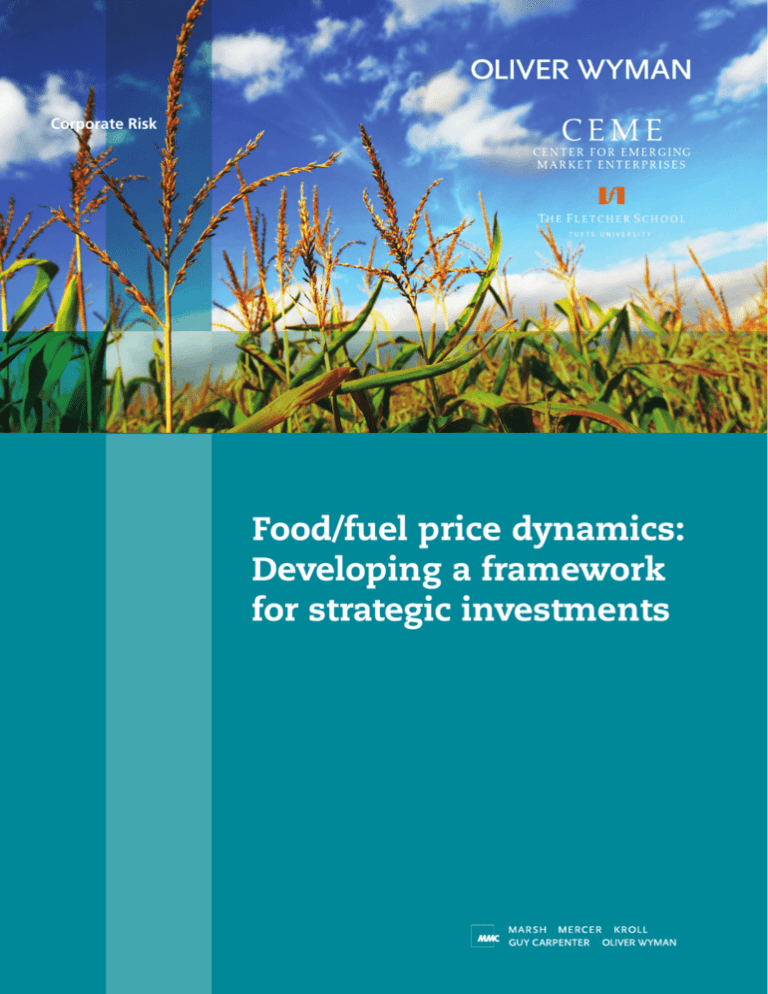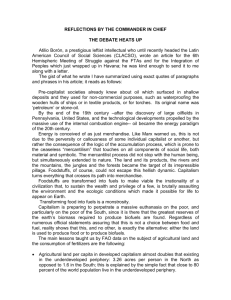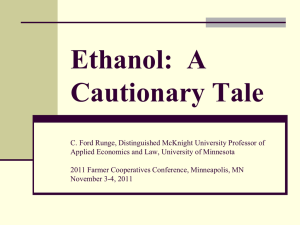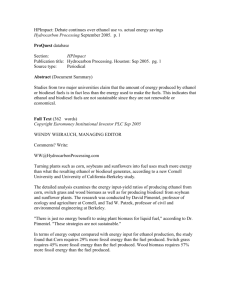
Corporate Risk
Food/fuel price dynamics:
Developing a framework
for strategic investments
Introduction
1
Mega-trends affecting food and fuel markets
2
What goes up…?
3
Correlations and causality
4
Decision support framework
7
Biofuels: Changing the game
8
Conclusion
11
Methodology
12
Introduction
At the height of the food and fuel price explosion in 2007 and early
2008, a heated debate arose about the relationship between these two
commodities’ markets. During the peak of the crisis, the prices of all
commodities rose, but the direct impact of higher food and energy costs on
citizens and companies captured the attention of governments, journalists,
commentators and analysts. Most observers made assumptions about the
food/energy relationship, the causes of the price fluctuations, and proposed
solutions with a general view that rising energy costs and the increased
use of biofuels were a core driver of rising food costs. Now that prices
have stabilized, the relationship is getting much less press, but detailed
research reveals that it is not as straightforward as it was portrayed
during that food-fuel price spike.
The potential for changing relationships among commodity group
prices driven by the emergence of biofuels presents both new risks
and new opportunities for many organizations. The purpose of
this study is to strip away previously held conceptions about the
relationship between the food and energy markets by testing some
common hypotheses, specifically:
1. The recent commodity price spike signaled a new era of
significantly increased prices
2. There is a strong correlation among commodity group prices,
particularly meat and grain prices such as beef and corn
3. Increased use of biofuels will change the relationship between
commodity groups with a significant impact on prices and demand
Our goal is to develop a thorough understanding of the relationship
between these commodity markets, based on rigorous data analyses,
to enable companies with different positions along the value chain to
develop perspectives on how to manage the risks or take advantage of
this dynamic environment.
This thorough understanding of the factors influencing commodity
prices can then be incorporated into a structured data analysis
process, such as the one shown on the following page. This was
the process used in performing this study and the approach can
be utilized whenever firms are confronted with strategic choices
that may be impacted by events in these volatile and potentially
interlinked markets.
Copyright © 2010 Oliver Wyman
1
Exhibit 1: Data analysis process
Key
questions
Data
requirement
Analytic
approach
Insight
What is the supply
volume impact?
History of acreage,
yields, weather
Regression of
variables on volumes
Native market
volume impacts
Are there close
supply substitutes?
Related supply
market impact
Are there close
demand substitutes?
Structural review and
price change
correlation
Production
requirements, maps,
price histories
Usage mapping, price
histories
Related demand
market impact
Direct energy impact
DOA historic
production cost
breakdowns
Structural review and
price change
correlation
What is the energy
intensity of
production and
transportation?
Correlated energy
volatility impact
Do biofuel crops
compete for this
crop’s acreage?
Mega-trends affecting food and
fuel markets
In the long term, price dynamics of commodities are driven by large
macroeconomic trends, many of them common for both food and
energy. Global population growth, as well as an increase in GDP per
capita, particularly in developing countries, has led to a growth in
demand for energy as it is substituted for human labor. Increasing
population and income levels have also driven demand for animal
proteins, with secondary effects including raising demand for animal
feed. Since the production of one pound of beef typically requires
seven pounds of feed, increased demand for meat can dramatically
drive up grain demand.
Resource constraints have also contributed to price volatility. For
example, the already limited supply of economically accessible oil
and natural gas is stressed by shifting geopolitics, carbon emission
regulations, and water requirements. On the food side, arable land
is limited, and that scarcity and highly variable fertilizer prices
contribute to uncertainty. At the same time, technological advances
such as energy efficiency, the emergence of renewable resources and
increasing agricultural yields, offset some of the supply constraints.
2
Copyright © 2010 Oliver Wyman
What goes up…?
In light of these factors, commodity prices appeared to be undergoing
a structural shift to higher levels in the long term, with the prospect
of significant future increases. However, an analysis of historical data
helps put the 2007-2008 prices in context.
Hypothesis
The recent commodity price spike signaled a new era of significantly
increased prices
Finding
Prices have returned to levels consistent with historical trends
Following a long period of relative stability, in 2006 the prices of major
crops had started to climb, almost tripling by mid-2008. However,
recent price escalation notwithstanding, agricultural commodity
and fuel price trends have been largely consistent over the past 50plus years. In the last 30 years, grain prices appear to have followed
a mean-reverting pattern, although it is hard to distill the precise
governing process as nominal prices are affected by inflation and
other factors. In real terms, grain prices have been falling since
the early 20th century, though more recently prices have been
relatively stable in nominal terms. It remains to be seen if this stable
or declining environment will continue, in light of increasingly
binding constraints driven by global warming and new uses of
agricultural resources like biofuels. Nonetheless, while the 2007
spike was seen by some as the beginning of a structural shift in the
price of commodities, the late 2008 price decline indicated that that
assessment may be premature.
Exhibit 2: Historical grain prices
Change in price
Indexed nominal price
6
5
4
3
2
1
0
2000
2001
2002
2003
2004
– Corn
2005
– Wheat
2006
2007
2008
– Rice
Source: United States Department of Agriculture (USDA)
Copyright © 2010 Oliver Wyman
3
Exhibit 3: Historical energy prices
Change in price
Indexed nominal price
6
5
4
3
2
1
0
2000
2001
2002
2003
2004
– Oil
2005
2006
2007
2008
– Natural gas
Source: Energy Information Administration (EIA)
Organizations active in the energy or food production sectors have
long expected to see short-term price fluctuations, but grains have
now clearly broken away from their long-term historical price
behavior. Volatilities have increased somewhat as supplies of many
commodities have grown increasingly stressed, but this is not
universally observed. Corn in particular has remained fairly stable.
Now, models and assumptions used for key decision support might
still be based on historical patterns, but stress tested using extreme
price changes such as those seen in the 2007-2009 period.
Correlations and causality
Commodities prices have always been, and are expected to remain,
volatile in the short term, and the level of volatility and correlations
exhibit several discernible characteristics. This is true within both the
energy and agricultural sectors.
Exhibit 4: Annualized volatilities
Energy commodities have long exhibited
the highest degree of price volatility.
Grains follow, and proteins exhibit the
lowest historical levels of price volatility.
This may be explained, at least in part, by
the cost of processing each good relative
to the input cost.
The correlations between the different
commodity prices can be broadly
understood to mean the extent to
4
Crude oil
29%
Gasoline
36%
Diesel
30%
Natural gas
52%
Ethanol
37%
Corn
20%
Rice
16%
Wheat
24%
Pork
16%
Beef
16%
Chicken
20%
Source: EIA and USDA data 2001-2008
Copyright © 2010 Oliver Wyman
which the prices move together. It is important for organizations
to understand how their input and output prices may change, both
individually and cohesively, in order to effectively plan and deal with
the risks in these markets.
During the recent food/energy price crisis, many commentators
attributed the rising food prices to rising energy, particularly fuel,
prices. Data analysis refutes the view that fuel prices were the sole, or
even a major, driver of food prices.
Hypothesis
There is a strong correlation among commodity group prices, particularly
meat and grain prices such as beef and corn
Finding
Price correlations are naturally higher within commodity groups, and the
price correlation between commodity groups is unexpectedly low
Given that many drivers, particularly on the demand and monetary side,
are common for all commodities, it is no surprise that all commodity
prices show some level of positive historical correlation, though it is
surprising that some of the correlations are not stronger.
Exhibit 5: Correlations within energy commodities
Crude oil
Gasoline
Diesel
Gasoline
0.97
Diesel
0.99
0.98
Ethanol
0.81
0.86
0.84
Natural gas
0.73
0.74
0.77
Ethanol
0.68
Price correlations within commodity groups are naturally high. The
energy commodities group has historically shown the highest internal
price correlations, and within these it is clear that the petroleum
products are the most closely related components.
The food commodities also exhibit higher correlations within their
groups, although the relationship among the grains is significantly
stronger than that among the proteins.
Exhibit 6: Correlations within food commodity groups
Corn
Rice
Rice
0.88
Wheat
0.91
0.81
Pork
Beef
Beef
0.49
Chicken
0.49
0.53
The factor driving these food price correlation levels appears to be
fungibility, and the low level of substitution among proteins may be
Copyright © 2010 Oliver Wyman
5
somewhat surprising. This may indicate that human consumption
patterns of these proteins are not primarily economic, but a function
of preferences, culture, and habit. As a result, rising beef prices do not
lead directly to increases in chicken consumption.
Similarly, the low correlation between meat and feedstock prices
was also unexpected, and may be due in part to different storage
characteristics (i.e., costs and storage lives). Overall, the recent
increases in corn prices had a limited impact on feed prices, which are
composed of many grains, some of them highly substitutable. The data
show that the increases in meat and poultry prices were significantly
lower than the price increases for crops (with one result being a
significantly reduced margin for meat and poultry farmers).
Exhibit 7: Correlations across food commodity groups
Corn
Rice
Wheat
Pork
0.29
0.51
0.17
Beef
0.50
0.65
0.46
Chicken
0.47
0.45
0.38
Perhaps most relevant to the food/fuel debate are the price
correlations between these two groups. Here we observe that the price
of ethanol has a higher correlation with petroleum products than
with corn, indicating that the demand linkage between ethanol and
gasoline is at least as, if not more, important than the cost structure
linkage between this feedstock (corn) and product (ethanol). This
is further demonstrated in the volumes demanded between 1999
and 2007, when consumption of ethanol quintupled, without any
concurrent major increase in corn prices.
Exhibit 8: Correlations between food and fuel commodities
Corn
Rice
Wheat
Pork
Beef
Chicken
Crude oil
0.82
0.87
0.85
0.48
0.61
0.35
Gasoline
0.76
0.82
0.77
0.55
0.66
0.40
Diesel
0.79
0.86
0.82
0.50
0.63
0.35
Natural gas
0.50
0.61
0.52
0.39
0.65
0.31
Ethanol
0.56
0.73
0.58
0.53
0.64
0.29
Examining the cost structure of corn as an example of how energy
costs could impact corn prices, it is true that two-thirds of operating
production expenses are directly or indirectly driven by fertilizer,
chemicals, or fuels. But the total operating expenses are roughly half
of total production costs and the direct fuel component alone is only
7-8% of the total costs. What these cost structures mean for a company
specializing in agriculture and food products is that the prices of their
6
Copyright © 2010 Oliver Wyman
end products do show some correlation with fuel costs and this effect is
more pronounced for grains than for proteins, as shown above.
Furthermore, it also suggests that rising energy costs alone cannot
account for the spike in food prices that put pressure on many of the
world’s poor through 2007 and 2008, and created increased uncertainty
regarding investments and strategic choices in both the food and
energy sectors.
Decision support framework
A deliberate and robust decision framework is essential to cut through
the fog of these food/energy price dynamics and quantify the real
relationships and market behaviors that will govern the success or
failure of large-scale investments in the long term. Organizations
throughout the supply chain can use this framework to understand
the sensitivity of their output prices to their input costs and the
interrelatedness of their products. Understanding volatility mediumterm can assist with large capital decisions, such as the construction
of new factories or introductions of new product lines. In addition
to understanding the volatility itself, a firm grasp of commodity
correlations is useful in recognizing how the volatilities of the various
factors in the value chain impact one another.
Exhibit 9: Decision support framework
Food supply
Agriculture
markets
Food demand
Biofuels supply
Biofuels markets
Biofuels demand
Electricity,
natural gas and
diesel supply
Energy markets
Electricity,
natural gas and
diesel demand
Food and
agricultural
prices are very
weakly impacted
by energy prices,
except in rare
cases associated
with biofuels
In the case of energy markets, only transportation fuels are linked to
the biofuels markets, and a complex regulatory infrastructure tends to
govern the demand side of these markets. However, as the demand for
biofuels increases, it threatens to change the game significantly.
Copyright © 2010 Oliver Wyman
7
Biofuels: Changing the game
Hypothesis
Increased use of biofuels will change the relationship between commodity
groups with a significant impact on prices and demand
Finding
Biofuels have yet to demonstrate a significant and lasting impact on prices or
demand – but that potential is clearly real
The commodities price spike in 2007 and early 2008 was caused
by a confluence of several factors, some of which were common to
all commodities. Chief among these were an extended period of
economic growth, particularly in India and China, driving demand
for commodities, and depreciation of the dollar. Relatively poor crops
in Australia, EU, and Ukraine in 2006 and 2007, and trade restrictions
imposed by many grain producing countries in 2006-2008 were casual
factors in agriculture. Two newer factors were the speculation in the
commodities markets by financial players and the increased grain
demand due to an expanded biofuels industry, although the historical
impact of either of these is less clear.
Biofuels are positioned to have a particularly interesting impact on
commodity markets and on the price dynamics across commodity
groups. They were never previously present in supply or demand side
volumes, and they establish an entirely new linkage between food and
fuel markets. Fuel and fertilizers are clearly components of the cost
structure of most grains, but the corn price is also a major component
of ethanol cost. Now, for the first time, not only does fuel affect grains,
but grains also affect fuel. Thus, it is incumbent on any company
operating in the food/fuel space to have an understanding and view on
the role biofuels are likely to play in the relationships between these
key commodities.
Biofuels are here to stay, thanks to several characteristics that make
them an appealing alternative to petroleum fuels – such as reduced
emissions, decreased dependency on foreign oil and a smaller
environmental impact – and to strong political support for biofuels
in the US, EU, and Brazil, among other markets. The dynamics of the
industry is heavily affected by the “blend wall,” or the maximum
percentage of biofuels that can be blended with a core fuel without
modifications to engines and infrastructure. At volumes below the
blend wall, a total of 10-12 billion gallons of ethanol annually (8-10%
of total gasoline consumption), the industry is effectively mature.
Price competition is a key consequence of such a mature industry and
margins tend to accrue to blenders rather than corn producers.
8
Copyright © 2010 Oliver Wyman
However, if the volume of ethanol demanded exceeded the levels
defined by the blend wall, the impact on the commodity markets
would be highly uncertain. Feedstock availability would be called into
question if corn harvests could not meet this higher demand, yet this
might have little impact on food product prices. As noted above, there
is a low correlation between meat and feedstock prices, and there is
no precedent for the relationships at such a high volumes.
Other scenarios include the emergence of alternative biofuels
(e.g., biodiesel) which would reduce the net demand for ethanol.
Technologically, the biofuels industry is still advancing; cellulosic
ethanol is promising but economically untested, and algae-based
technologies are appealing but also unproven. The economics of
both are likely to be highly location-specific. Furthermore, consumer
acceptance of ethanol is not a given as it is inherently inferior to
petroleum gasoline in terms of several performance measures. The
future of biofuels is also dependent on infrastructure investments
and regulatory support, which will undoubtedly be impacted by
national and international policy and the level of enforcement
of those mandates. This diverse range of possible scenarios that
describe how the biofuel market might evolve, serves to highlight the
uncertainties in both the near and longer term.
Copyright © 2010 Oliver Wyman
9
Conclusion
In summary, this study reveals that:
Recent price spike notwithstanding, long-term agricultural
commodity and fuel price trends have been largely consistent over
the past 50-plus years
Price correlations are higher within commodity groups, and the
correlation between commodity groups is unexpectedly low
There is a low level of substitution among animal proteins
There is low correlation between meat and feedstock prices
Rising energy prices have had a greater impact on biofuel prices
and demand than rising feedstock or food prices
If fuel prices rapidly increase again or if ethanol mandates are
enforced, ethanol prices can be expected to rise, and could put
pressure on corn prices
Together, these observations support a view of food/energy price
dynamics in which grain prices are typically only loosely related to
fuel prices. But the observations also reveal that that price linkage
could become quite strong under a number of plausible scenarios
(i.e., increased ethanol demand). In addition, the volatilities, levels
and relationships among the prices of these commodities are quite
idiosyncratic, requiring detailed analysis of the precise commodities of
interest before robust conclusions can be drawn.
Even though predicting short-term volatility or correlations is anything
but accurate, in the medium-term, a risk manager or strategist
thinking about the relative market dynamics of specific food and
fuel commodities can use a disciplined framework to address each
commodity’s inherent properties. The most salient of these include:
Production cycle
Storability
Transportability
Fungibility
Strategic importance
10
Copyright © 2010 Oliver Wyman
All of these play roles in the supply and demand dynamic identified
in the decision support framework. Ultimately that framework must
address the supply side and demand side of each relevant market,
and assess the extent to which these may be related. Several energy
and food markets were examined in this study, and one key finding
is that each specific market is quite different. If crucial strategic
or investment decisions are to be guided by any analyses of these
markets, the analysis must be thorough, robust, and specific.
The historical escalation of food prices around 2007 was the result of
numerous factors, and detailed analyses show that ethanol demand
appears to have played a very minor role, if any at all. That said, corn is
currently the key feedstock in ethanol, whose demand is expected to
grow exponentially in the near future. Envisioned demand for ethanol
will create the potential for dramatic corn price escalation. Mitigating
the explosive growth in biofuel demand are political, technical, and
infrastructure barriers, and a good deal of uncertainty. While the current
link between food and fuel prices is weak at best, these unknowns may
continue to drive volatility until they are resolved.
Methodology
This paper is the result of a joint study by Oliver Wyman and
The Center for Emerging Market Enterprises, Tufts University. The goal
of the study was to examine the implications of the dual use of
commodities for both food and energy and to draw together the
key facts required to guide multinational corporations through an
increasingly complex decision-making environment.
This study began with statistical analysis of the price levels and
correlations of five fuels (crude, gasoline, diesel, natural gas, and
ethanol), three grains (rice, wheat, and corn), and three proteins (beef,
pork, chicken). That was followed by economic analysis of the fuel
and food value chains, including technology, cost structure, industry
supply curves, bottlenecks, availability of feedstock, infrastructure,
retail, demand analysis, and consumer preferences. Also included
in the analysis was an assessment of relevant public policy issues,
including regulations and trade patterns.
The quantitative analysis was followed by interviews with leading
participants along the value chains. Companies interviewed in
the food sector specialized in agricultural inputs, production and
commodity markets, as well as food processors and companies
in the retail food sector. Fuel sector interviewees included biofuel
production and retail fuel companies.
Copyright © 2010 Oliver Wyman
11
Oliver Wyman is an international management consulting firm that combines deep industry knowledge
with specialized expertise in strategy, operations, risk management, organizational transformation, and
leadership development.
The Center for Emerging Market Enterprises at The Fletcher School, Tufts University is global hub for
enterprise-based research, study, and networking. Core research topics, including enterprise strategy,
local capital markets, energy and commodity markets, and inclusive commerce, address critical issues for
businesses operating in emerging markets. For more information, please visit http://fletcher.tufts.edu/ceme.
Copyright © 2010 Oliver Wyman. All rights reserved. This report may not be reproduced or redistributed, in whole or in part, without the written
permission of Oliver Wyman and Oliver Wyman accepts no liability whatsoever for the actions of third parties in this respect.
The information and opinions in this report were prepared by Oliver Wyman.
This report is not a substitute for tailored professional advice on how a specific financial institution should execute its strategy. This report is not
investment advice and should not be relied on for such advice or as a substitute for consultation with professional accountants, tax, legal or financial
advisers. Oliver Wyman has made every effort to use reliable, up-to-date and comprehensive information and analysis, but all information is provided
without warranty of any kind, express or implied. Oliver Wyman disclaims any responsibility to update the information or conclusions in this report.
Oliver Wyman accepts no liability for any loss arising from any action taken or refrained from as a result of information contained in this report or any
reports or sources of information referred to herein, or for any consequential, special or similar damages even if advised of the possibility of such damages.
This report may not be sold without the written consent of Oliver Wyman.
For more information please contact the marketing department by email at corporaterisk@oliverwyman.com
or by phone at one of the following locations:
North America
EMEA
Asia Pacific
+1 212 541 8100
+44 20 7333 8333
+65 6510 9700









